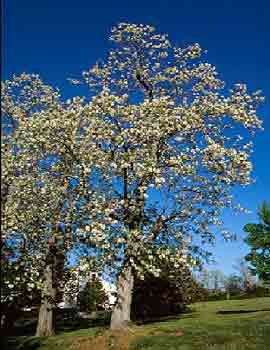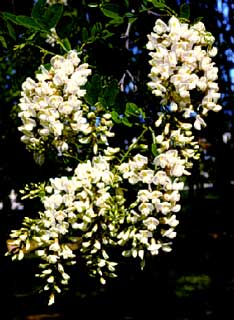 Black Locust - Robinia pseudoacacia
Black Locust - Robinia pseudoacacia
Pea Family (Fabaceae)
- Native habitat: Pennsylvania to Georgia, west to Iowa, Missouri and Oklahoma.
- Growth habit: Often upright with a straight trunk. Form varies with cultivar.
- Tree size: Choose cultivars in the 20- to 30-foot range. Growth rate is fast.
- Flower and fruit: Flowers are perfect, white or rose-pink, 1 inch across and borne in May in 4- to 8-inch-long racemes. Even young trees flower. Fruit is a flat, brown-black pod, 2 to 4 inches long and dry and paper-like.
- Leaf: Leaves are alternate, pinnately compound and 6 to 14 inches long. Each leaf includes seven to 19 leaflets that are 1 to 2 inches long. Leaves are dark blue-green in summer and yellow-green in fall. Black locust drops its leaves early in fall.
- Hardiness: Winter hardy to USDA Zone 3.
- ‘Frisia' - This tough tree is drought-tolerant and has an oval form with upright arching branches. Summer foliage is bright yellow, then turns golden yellow in fall. Flowers are white.
- ‘Inermis' - A thornless cultivar, this tree is small (20 feet tall) and globe-shaped.
- ‘Purple Robe' - This compact, rounded cultivar, one of the most attractive forms, should not exceed 30 to 40 feet in height. It has lovely, dark rose-pink flowers. New growth is bronzy red. It is short-lived and prone to borer injury.
- ‘Pyramidalis' (‘Fastigiata') - This upright, columnar cultivar will tolerate poor soils. It is spineless. Its shape is similar to Lombardy poplar, as it reaches a height of 40 feet with a width of 15 feet. Foliage is medium green in summer and yellow in fall. Flowers are white and in clusters.
- ‘Tortuosa' - This small cultivar has contorted branches.
- ‘Umbraculifera' - An interesting cultivar that forms an flat, umbrella-like top. Although uncommon in the U.S., it is a common landscape and street tree in Northern European gardens.
 Additional information:
Additional information:The bark of black locust is reddish brown to almost black with deep furrows. Bees make a delicious honey from black locust flowers. Locust pods are eaten by livestock and wildlife.
Near the end of the 18th century black locust became extremely popular in Europe. It is thought that the botanist for France's Henry IV, Jean Robin, or his son Vespasien, sent seeds of black locust, probably from Louisiana, to Europe in the early 17th century.
Although decay organisms destroy living wood rapidly, once cut, black locust has durable, hard wood. Posts made of locust wood will last at least 50 years. It was once a prized tree for making ship masts.
Black locust is an interesting plant. It is native to North America, where it is hardly used (partly due to pest problems). In contrast, it is a common tree in Europe and numerous interesting cultivars have been selected. In China, where very few imported plants are used, black locust has escaped and I have seen it take over mountainsides at the expense of native Chinese flora.



